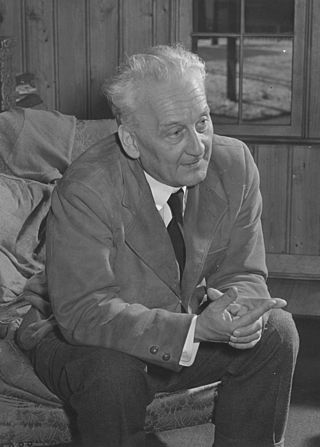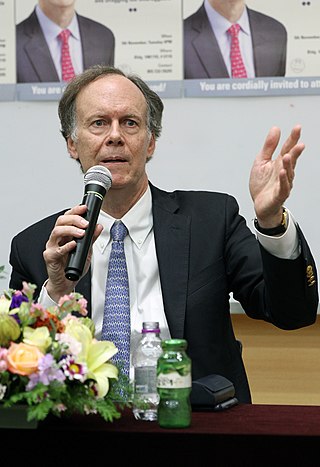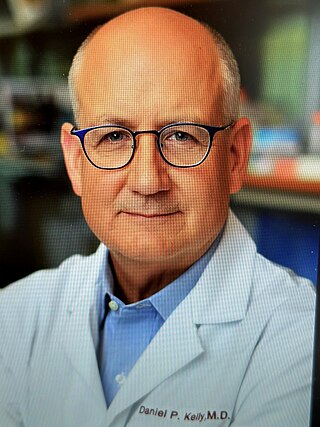Related Research Articles

Imatinib,sold under the brand names Gleevec and Glivec (both marketed worldwide by Novartis) among others,is an oral targeted therapy medication used to treat cancer. Imatinib is a small molecule inhibitor targeting multiple tyrosine kinases such as CSF1R,ABL,c-KIT,FLT3,and PDGFR-β. Specifically,it is used for chronic myelogenous leukemia (CML) and acute lymphocytic leukemia (ALL) that are Philadelphia chromosome–positive (Ph+),certain types of gastrointestinal stromal tumors (GIST),hypereosinophilic syndrome (HES),chronic eosinophilic leukemia (CEL),systemic mastocytosis,and myelodysplastic syndrome.

The Indiana University School of Medicine (IUSM) is a major,multi-campus medical school located throughout the U.S. state of Indiana and is both the undergraduate and graduate medical school of Indiana University. There are nine campuses throughout the state;the principal research,educational,and medical center is located on the campus of Indiana University Indianapolis. With 1,461 MD students,195 PhD students,and 1,442 residents and fellows in the 2023–24 academic year,IUSM is the largest medical school in the United States. The school offers many joint degree programs including an MD/PhD Medical Scientist Training Program. It has partnerships with Purdue University's Weldon School of Biomedical Engineering,other Indiana University system schools,and various in-state external institutions. It is the medical school with the largest number of graduates licensed in the United States per a 2018 Federation of State Medical Boards survey with 11,828 licensed physicians.

Stanley Alan Plotkin is an American physician who works as a consultant to vaccine manufacturers,such as Sanofi Pasteur,as well as biotechnology firms,non-profits and governments. In the 1960s,he played a pivotal role in discovery of a vaccine against rubella virus while working at Wistar Institute in Philadelphia. Plotkin was a member of Wistar’s active research faculty from 1960 to 1991. Today,in addition to his emeritus appointment at Wistar,he is emeritus professor of Pediatrics at the University of Pennsylvania. His book,Vaccines,is the standard reference on the subject. He is an editor with Clinical and Vaccine Immunology,which is published by the American Society for Microbiology in Washington,D.C. and one of the leading vaccine advocates. Dr. Plotkin disclosed his consulting work for various vaccine manufacturers as a potential conflict of interest to his vaccine advocacy,including Merck,GSK,Sanofi,and Pfizer,as well as multiple biotech companies.
Lawrence Einhorn is an American oncologist at Indiana University School of Medicine. A pioneer in cancer treatment research,Einhorn developed cisplatin-based chemotherapy regimens that increased cure rates while minimizing toxic side effects.

A neurofibroma is a benign nerve-sheath tumor in the peripheral nervous system. In 90% of cases,they are found as stand-alone tumors,while the remainder are found in persons with neurofibromatosis type I (NF1),an autosomal-dominant genetically inherited disease. They can result in a range of symptoms from physical disfiguration and pain to cognitive disability.
The Crowe sign or Crowe's sign is the presence of axillary (armpit) freckling in people with neurofibromatosis type I. These freckles occur in up to 30% of people with the disease and their presence is one of six diagnostic criteria for neurofibromatosis. Freckles can also be present in the intertriginous area in neurofibromatosis,such as the inguinal fold,submammary areas,and nape of the neck.

Friedrich Daniel von Recklinghausen was a German pathologist born in Gütersloh,Westphalia. He was the father of physiologist Heinrich von Recklinghausen (1867–1942).

The Children's Tumor Foundation (CTF) is a 501(c)(3) foundation dedicated to improving the health and well-being of individuals and families affected by NF,a group of genetic conditions known as neurofibromatosis or schwannomatosis. Their four-part mission includes propelling drug research and development through a series of strategic investments,strengthening patient support,increasing public awareness of NF and establishing best practices in clinical care for affected individuals. The Foundation is incorporated in all 50 states with active chapters and affiliates in 37 states. CTF is the largest private funder of all forms of NF research.
The Duke University School of Medicine,commonly known as Duke Med,is the medical school of Duke University. It was established in 1925 by James B. Duke.

Brian J. Druker,M.D. is a physician-scientist and JELD-WEN Chair of Leukemia Research at Oregon Health &Science University (OHSU) in Portland,Oregon. He previously served as chief executive officer and director of OHSU's Knight Cancer Institute,as well as Associate Dean for Oncology in the OHSU School of Medicine.

George Quentin Daley is the Dean of the Faculty of Medicine,Caroline Shields Walker Professor of Medicine,and Professor of Biological Chemistry and Molecular Pharmacology at Harvard Medical School. He was formerly the Robert A. Stranahan Professor of Pediatrics at Harvard Medical School,Director of the Stem Cell Transplantation Program at Boston Children's Hospital,and an investigator of the Howard Hughes Medical Institute,Associate Director of Children's Stem Cell Program,a member of the Executive Committee of the Harvard Stem Cell Institute. He is a past president of the International Society for Stem Cell Research (2007–2008).

The Szent-Györgyi Prize for Progress in Cancer Research,established by National Foundation for Cancer Research (NFCR) and named in honor of Albert Szent-Györgyi,Nobel laureate and co-founder of NFCR,has been awarded annually since 2006 to outstanding researchers whose scientific achievements have expanded the understanding of cancer and whose vision has moved cancer research in new directions. The Szent-Györgyi Prize honors researchers whose discoveries have made possible new approaches to preventing,diagnosing and/or treating cancer. The Prize recipient is honored at a formal dinner and award ceremony and receives a $25,000 cash prize. In addition,the recipient leads the next "Szent-Györgyi Prize Committee" as honorary chairman.

William G. Kaelin Jr. is an American Nobel laureate physician-scientist. He is a professor of medicine at Harvard University and the Dana–Farber Cancer Institute. His laboratory studies tumor suppressor proteins. In 2016,Kaelin received the Albert Lasker Award for Basic Medical Research and the AACR Princess Takamatsu Award. He also won the Nobel Prize in Physiology or Medicine in 2019 along with Peter J. Ratcliffe and Gregg L. Semenza.

David Hillel Gutmann is an American neurologist-neuroscientist. He teaches at Washington University in St. Louis,where he is the Donald O. Schnuck Family Professor,and Director of the Washington University Neurofibromatosis Center. He is an international expert in Neurofibromatosis,pioneering the use of preclinical models to understand brain tumors and neurodevelopmental delays in children with NF1.
Marc E. Rothenberg is an American physician-scientist who has made significant contributions to the fields of allergy,gastroenterology,and immunology. He is currently a Professor of Pediatrics,at Cincinnati Children's Hospital Medical Center,and the University of Cincinnati College of Medicine,the Director of the Division of Allergy and Immunology,the Director of the Cincinnati Center for Eosinophilic Disorders,and the principal investigator of the Consortium of Eosinophilic Disease Researchers (CEGIR) as part of the Rare Disease Clinical Research Network of the National Institute of Health. Rothenberg's research is focused on eosinophilic gastrointestinal diseases.
Samir S. Shah is an American pediatric hospital medicine and pediatric infectious disease physician. Shah's research has focused on improved management of patients with common childhood infections,particularly pneumonia and meningitis.
John Matthew Maris is an American pediatric oncologist. He is the Giulio D’Angio Endowed Professor of Pediatrics at the Children's Hospital of Philadelphia (CHOP) and Full Professor at the Perelman School of Medicine at the University of Pennsylvania.

Daniel P. Kelly is Director of the Penn[1][2] and CHOP[3][4] Cardiovascular Institutes (CVI) and the Willard and Rhoda Ware Professor of Diabetes and Metabolic Diseases at the University of Pennsylvania Perelman School of Medicine and the Rachel Ash Presidential Professor at Children’s Hospital of Philadelphia (CHOP). He is a cardiologist and physician-scientist recognized for his contributions to the transcriptional control of mitochondrial function and the metabolic origins of heart disease.
Brownsyne Tucker Edmonds is a health equity researcher and physician in the Indiana University School of Medicine as well as the current Inaugural Vice President and Chief Health Equity Officer for IU Health. She also is the Indiana State Legislative Chair for the American Congress of Obstetricians and Gynecologists. She is an Associate Professor of Obstetrics and Gynecology as well as Clinical Pediatrics in the Indiana University School of Medicine. Her research focuses on making healthcare more equitable for marginalized patients.
Pisit Pitukcheewanont,also known as "Dr. Duke" is a Doctor of Medicine,a former professor of Clinical Pediatrics and a philanthropist. Currently,he is an adjunct professor of Clinical Pediatrics at Keck School of Medicine of the University of Southern California,the president of a nonprofit organization,The Human Growth Foundation and Senior Vice President of Global Clinical Development and Medical Affairs Lumos Pharmacy.
References
- 1 2 3 "Wells Center scientists among Indiana's "homegrown" researchers". Indiana University. March 6, 2014. Retrieved October 6, 2021.
- 1 2 Harris, Matthew (2020). "WADE CLAPP – HANOVER". Phi Delta Theta. Retrieved October 6, 2021.
- ↑ "D. Wade Clapp, MD". American Society for Clinical Investigation . Retrieved October 6, 2021.
- ↑ "Gleevec Holds Potential As First Drug To Successfully Treat Neurofibromatosis, Scientists Report". Science Daily. October 31, 2008. Retrieved October 6, 2021.
- 1 2 "Physician-researcher Wade Clapp Named IU Pediatrics Department Chairman". Indiana University. August 3, 2009. Retrieved October 6, 2021.
- ↑ "IU scientists to lead $12 million national initiative for new treatments for inherited cancers". Indiana University. August 31, 2015. Retrieved October 6, 2021.
- ↑ "Clapp elected to National Academy of Medicine". Indiana University. October 19, 2020. Retrieved October 6, 2021.
- ↑ "Dr. D. Wade Clapp Receives the Children's Tumor Foundation's Friedrich von Recklinghausen Award". Children’s Tumor Foundation. June 15, 2020. Retrieved October 6, 2021.
- ↑ "11 IU faculty named distinguished professors". Indiana University. February 10, 2021. Retrieved October 6, 2021.